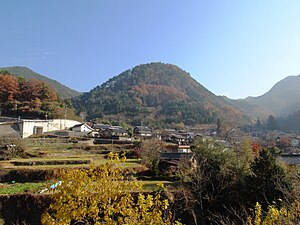Yōgaiyama Castle
| Yōgaiyama castle 要害山城 | |
|---|---|
| Kōfu, Yamanashi, Japan | |
 | |
| Coordinates | 35°42′10.93″N 138°35′53.61″E / 35.7030361°N 138.5982250°E |
| Type | Yamashiro |
| Site information | |
| Condition | Not extant |
| Site history | |
| Built | 1520 |
| Built by | Takeda Nobutora |
| In use | 1520-1600 |
| Materials | Wood, earthwork |
Yōgaiyama Castle (要害山城, Yōgaiyama-jō) was a Sengoku period yamajiro located in Kai Province (present day Yamanashi Prefecture), constructed in the 1520s by the Takeda clan. Since 1991, its site has been proclaimed a National Historic Site by the Japanese government.
Takeda Nobutora (1493-1573) secured control over Kai Province after various battles, and established the center of his government at Tsutsujigasaki in what is now the city of Kōfu in 1519. The Tsutsujigasaki residence was fortified with moats, but was unsuitable for withstanding a siege, so Nobutora fortified a nearby 770 metres (2,530 ft) mountain, Yōgaiyama with wooden and earthworks defenses and built a signal tower on its summit.
In 1521, Nobutora faced an invasion of a 15,000-man army from neighboring Suruga Province led by Imagawa clan general Fukushima Masanari in support of the rebellion of the Ōi clan against Takeda rule. Nobutora sent his wife, the daughter of Ōi Nobusato, to the Yogaiyama Castle for safekeeping. She gave birth to a son the day before Nobutora defeated the invasion at the Battle of Iidagawara, and in celebration of the event, Nobutora named the son, the future Takeda Shingen “Katsuchiyo”. In 1576, Shingen’s son, Takeda Katsuyori ordered that the fortifications be repaired. After the fall of the Takeda clan, the castle was controlled by a succession of retainers of Tokugawa Ieyasu, followed by Toyotomi Hideyoshi, one of whom, Katō Mitsuyasu made some further modifications to the defenses. However, after the Battle of Sekigahara in 1600, the castle was abandoned.
At present, all that remains of the castle are some foundation stones and remnants of earthenworks of the motte-and-bailey structures. On 31 March 1991, the area was designated a National Historic Site by the Japanese government.
See also
References
- Inoue Munekazu. Nihon no Meijo. Yuzankaku publishing (1992). ISBN 4639011075
